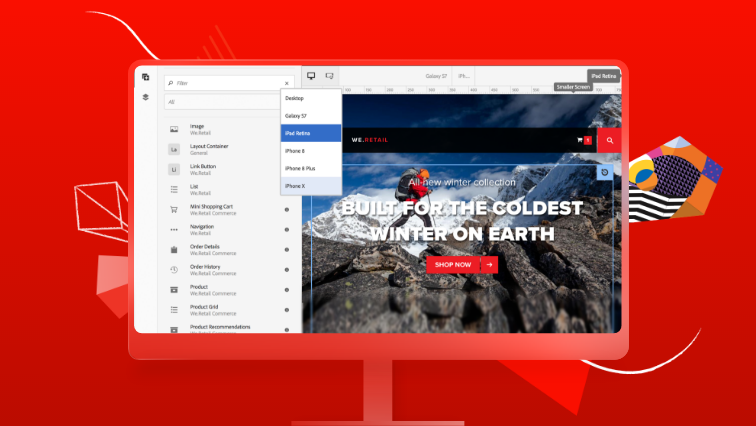Adobe Experience Manager (AEM) is a powerful and comprehensive content management solution developed by Adobe Systems. It is a leading digital experience management platform that enables organizations to create, manage, optimize, and deliver dynamic digital experiences across various channels, including web, mobile, email, and social media. What is AEM, AEM serves as a one-stop solution for businesses to deliver engaging, personalized, and consistent content to their target audience.
Key Features of AEM
Adobe Experience Manager comes equipped with a wide range of features that facilitate efficient content management and digital experience delivery:
1. Web Content Management (WCM):
AEM allows users to create and manage web content seamlessly with its user-friendly interface. It offers a WYSIWYG editor and drag-and-drop functionality, making it easy for content creators and marketers to publish content without any technical knowledge.
2. Digital Asset Management (DAM):
With DAM capabilities, AEM enables the storage, organization, and retrieval of digital assets, such as images, videos, and documents, in a central repository. This streamlines the content creation process and ensures consistent branding.
3. Personalization and Targeting:
AEM’s advanced personalization features enable marketers to deliver personalized content to different user segments based on their preferences, behavior, and demographics, enhancing the overall user experience.
4. Integration with Marketing Tools:
AEM seamlessly integrates with various marketing tools, such as Adobe Analytics and Adobe Target, allowing businesses to gather insights, perform data-driven optimizations, and deliver targeted campaigns.
How Adobe Experience Manager Works
Content Management
AEM provides a collaborative environment for content creation, review, and approval. Its intuitive interface allows multiple teams to work together, ensuring content consistency and compliance with brand guidelines.
Digital Asset Management
AEM’s DAM capabilities empower users to store, manage, and share digital assets efficiently. It automatically converts assets into the appropriate format, making them easily accessible for various channels and devices.
Personalization and Targeting
AEM leverages user data and behavior to deliver personalized content in real-time. Marketers can create personalized experiences based on customer segments, leading to higher engagement and conversion rates.
Integration with Marketing Tools
By integrating with other Adobe Marketing Cloud solutions, AEM enables marketers to analyze and optimize content performance, implement A/B testing, and deliver targeted campaigns.
Benefits of Using Adobe Experience Manager
Enhanced User Experience
AEM’s personalization capabilities ensure that users receive relevant and engaging content, enhancing their overall digital experience. This results in increased customer satisfaction and loyalty.
Streamlined Content Management
With AEM, content creation, review, and publishing become streamlined processes, reducing the time and effort required for content updates and ensuring content consistency.
Improved Marketing Efficiency
AEM’s integration with marketing tools allows marketers to make data-driven decisions, optimize campaigns, and measure the impact of their efforts, leading to improved marketing efficiency and ROI.
Scalability and Flexibility
AEM is highly scalable and adaptable, making it suitable for businesses of all sizes and industries. It can accommodate growing content volumes and evolving business needs without compromising performance.
Use Cases of Adobe Experience Manager
E-commerce Websites
AEM is ideal for e-commerce websites, as it allows businesses to deliver personalized product recommendations, optimize search results, and create seamless shopping experiences.
Brand Websites
AEM’s WCM features enable brands to create and maintain visually appealing websites with interactive content, driving engagement and brand loyalty.
Intranet and Collaboration Portals
AEM facilitates efficient internal communication and collaboration by providing secure intranet and collaboration portals, ensuring smooth information flow within organizations.
AEM Implementation Process
Planning and Strategy
The implementation process begins with defining project goals, identifying key stakeholders, and formulating a comprehensive strategy that aligns with the organization’s objectives.
Content Migration
During this phase, existing content is migrated to the AEM platform, ensuring seamless continuity and preserving metadata and content relationships.
Customization and Integration
AEM is customized to meet specific business requirements, and integration with existing systems and third-party tools is performed for enhanced functionality.
Testing and Deployment
The customized AEM solution undergoes rigorous testing to identify and resolve any issues before final deployment. Post-deployment support and training are provided to ensure a smooth transition.
Common Challenges with Adobe Experience Manager
Complexity of Implementation
Implementing AEM can be complex and time-consuming, requiring specialized skills and expertise. Proper planning and collaboration are essential to overcome implementation challenges.
Integration Issues
Integrating AEM with existing systems and third-party tools may present challenges, but with proper configuration and testing, seamless integration can be achieved.
Training and Support
Training employees to use AEM effectively is crucial for maximizing its benefits. Adequate training and ongoing support are essential to ensure users can utilize the platform to its full potential.
AEM vs. Other CMS Platforms
Comparing Features and Capabilities
AEM’s robust feature set, including personalization, DAM, and marketing tool integration, sets it apart from traditional CMS platforms.
Advantages and Disadvantages
While AEM offers advanced capabilities, it may come with higher costs and complexity compared to simpler CMS solutions.
Future Trends and Developments in AEM
As technology evolves, AEM is likely to incorporate more advanced AI and machine learning capabilities, enabling even more sophisticated personalization and content optimization.
Conclusion
Adobe Experience Manager is a leading digital experience management platform that empowers businesses to create compelling, personalized digital experiences. With its extensive features and seamless integration with other marketing tools, AEM remains a top choice for organizations seeking to enhance their online presence and engage with their audience effectively.
FAQs
- Is Adobe Experience Manager suitable for small businesses?
- Yes, while AEM is often associated with large enterprises, its scalability and flexibility make it suitable for small and medium-sized businesses as well.
- Can AEM be used for mobile app development?
- AEM primarily focuses on web content management, but it can be integrated with Adobe’s mobile app development solutions to deliver consistent content across multiple channels.
- Does AEM require coding knowledge for content management?
- No, AEM’s user-friendly interface allows content creators and marketers to manage content without extensive coding knowledge.
- How does AEM ensure content security?
- AEM incorporates robust security features and access controls, safeguarding content from unauthorized access and data breaches.
- Can AEM be hosted on cloud platforms?
- Yes, AEM can be deployed on cloud platforms, providing businesses with greater scalability, flexibility, and cost-effectiveness.







